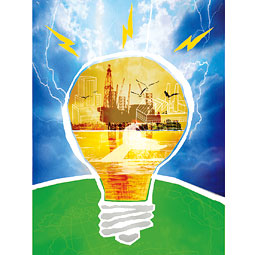At Washington State University’s inaugural high school energy competition on May 10, Bohler Gymnasium on the Pullman campus buzzed with the ideas and enthusiasm of more than 350 high school students.
Teams from across the state were invited to present ideas for sustainable living in one of four areas: technology, design, personal behavior, or society/public policy.

Eighty-six teams gathered to share ideas that ranged from specific proposals to encourage more recycling in one high school to schematic designs for a pedestrian-friendly community. One team proposed stackable greenhouses that would allow every community to “buy local,” and another team designed a Lego-like car that could be reconfigured for different uses, eliminating the need for multiple cars. Some teams came with fully-developed projects that were up and running (a school-wide challenge to lower CO2 emissions) and other teams came with impressive progress toward an elusive goal (using algae to sequester CO2 emissions during concrete production).
“The whole thing is just amazing,” said Jeff Johnson, a senior systems engineer at Microsoft and a judge for the competition. “The ideas, energy and passion—it’s just inspiring, frankly.”
Nearly $100,000 in prize money, contributed by seven premier sponsors, was handed out to individual teams and their schools. The grand prize—and breakfast with Denis Hayes, founder of Earth Day and president of the Bullitt Foundation—went to a three-person team from Lake Roosevelt High in Grand Coulee for their project, “Customizable Hydrogen Production.”
“This definitely has been a life-changing experience for me,” said Elizabeth Owen, 18, who led an effort to build a wind belt as part of her team’s submission. A wind belt, which Owen saw on an internet video clip and figured out how to build, captures the energy created by a wind-powered flutter or vibration, rather than the rotation of a turbine, and is potentially much more efficient and less expensive than current wind technology.
Teammate Peter Rise built one solar panel from 35 solar cells and Catherine Kerns created a hydropower generator. Then, the energy generated from the wind, sun, and water was routed to an electrolyzer that produced hydrogen gas and then that gas was used to power a fuel cell. Finally, the fuel cell ran a small motor.
Owen said she knew her team had created something special when the judges gathered around the models. At one point, she said, there were about nine judges—WSU faculty members as well as industry experts—asking questions.
Talking with faculty members was her favorite part of the experience, she said. “I loved seeing their expressions when they found out about the wind belt,” she said. “They were these really brilliant people and I got to explain something to them that they didn’t know about.”
Owen was the only senior in the group, and prior to the competition college was a distant idea—perhaps to become an art teacher—but not really a plan. Now, she said, all that has changed. Next year she hopes to attend WSU and would like to pursue a career in alternative energy technology.
Each member of the group received $5,000 in prize money, and the school received another $5,000. Ralph Rise, a science teacher, and Lee Argent, an industrial arts teacher, were advisors on the project. The team was also assisted by Stephen Dent, a WSU graduate student in engineering who works with high school students as part of a National Science Foundation grant.
“We are going to use the money as seed money for our next project,” Ralph Rise said, adding that the group already has ideas about developing a solar-powered dragster.
More than 27 organizations contributed to the event, including premier sponsors BP Cherry Point, The Boeing Company, The Bullitt Foundation, Vulcan Inc., The Seattle Times, Washington State Department of Ecology, and Weyerhaeuser.
